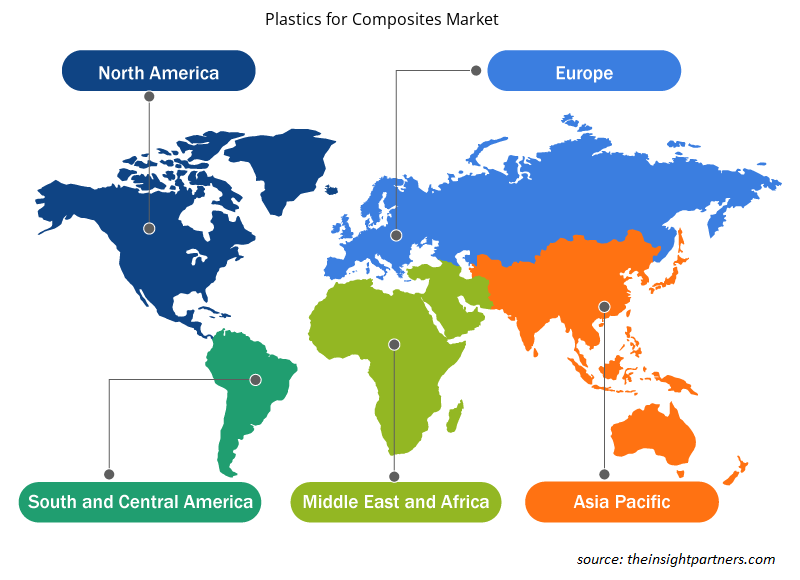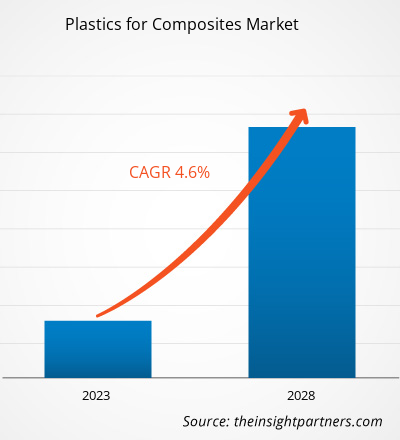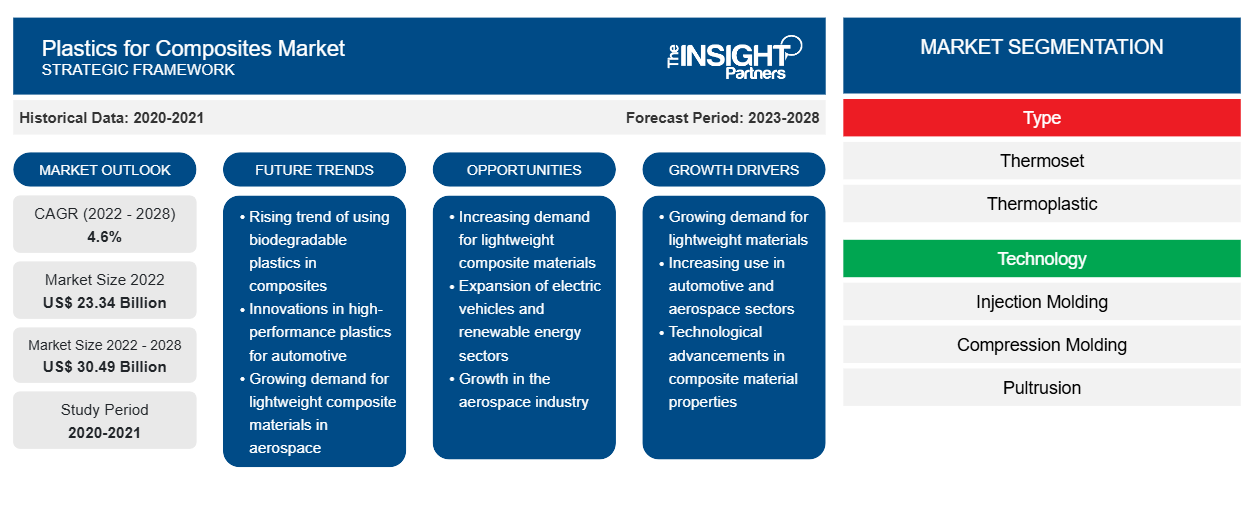Der Markt für Kunststoffe für Verbundwerkstoffe soll von 23.337,24 Millionen US-Dollar im Jahr 2022 auf 30.490,85 Millionen US-Dollar im Jahr 2028 wachsen; von 2022 bis 2028 wird eine durchschnittliche jährliche Wachstumsrate (CAGR) von 4,6 % erwartet.CAGR of 4.6% from 2022 to 2028.
Verbundwerkstoffe sind Materialien, die aus zwei oder mehr chemisch und physikalisch unterschiedlichen Phasen bestehen, die durch eine unterschiedliche Schnittstelle getrennt sind. Die meisten kommerziell hergestellten Verbundwerkstoffe verwenden ein Polymermatrixmaterial, das oft als Harzlösung bezeichnet wird. Häufig verwendete Polymermatrizen sind Polyester, Vinylester, Epoxid, Phenol, Polyimid, Polyamid, Polypropylen und Polyetheretherketon (PEEK). Niedrige Kosten, einfache Verarbeitbarkeit, gute chemische Beständigkeit und geringes spezifisches Gewicht sind einige der Hauptvorteile von Polymermatrizen.phenolic, polyimide, polyamide, polypropylene, and polyether ether ketone (PEEK). Low cost, easy processability, good chemical resistance, and low specific gravity are among the major advantages associated with polymer matrices.
Die zunehmende Verwendung von Verbundharzen in Bau- und Konstruktionsaktivitäten sowie in der Luft- und Raumfahrt und im Militärbereich trägt zum Wachstum des Marktes für Kunststoffe für Verbundwerkstoffe bei . Darüber hinaus ist die Nachfrage nach Leichtbaumaterialien im Fahrzeugbau zur Verbesserung der Kraftstoffeffizienz ein weiterer Faktor, der die Expansion des Marktes vorantreibt. Darüber hinaus trägt die steigende Nachfrage nach thermoplastischen Harzen erheblich zum Gesamtwachstum des Marktes für Kunststoffe für Verbundwerkstoffe bei. Steife Fasern und höhere Hitzebeständigkeit, Rissfestigkeit, hohe Schlagfestigkeit und eine robuste Polymermatrix sind die Hauptmerkmale von Polymerverbundwerkstoffen, die ihre Popularität vorantreiben. Steigende Investitionen in die Erzeugung erneuerbarer Energien werden in den kommenden Jahren wahrscheinlich die Nachfrage nach Polymerverbundwerkstoffen ankurbeln.
Passen Sie diesen Bericht Ihren Anforderungen an
Sie erhalten kostenlos individuelle Anpassungen an jedem Bericht, einschließlich Teilen dieses Berichts oder einer Analyse auf Länderebene, eines Excel-Datenpakets sowie tolle Angebote und Rabatte für Start-ups und Universitäten.
-
Holen Sie sich die wichtigsten Markttrends aus diesem Bericht.Dieses KOSTENLOSE Beispiel umfasst eine Datenanalyse von Markttrends bis hin zu Schätzungen und Prognosen.
Markteinblicke
Steigende Nachfrage aus der Automobil- und Luftfahrtindustrie treibt das Wachstum des Marktes für Kunststoffe für Verbundwerkstoffe voran
Das Verbundharz wird in verschiedenen Anwendungen eingesetzt, darunter Bauwesen und Infrastruktur, Transport, Elektrik und Elektronik, Windenergie, Pipelines und Tanks, Schifffahrt sowie Luft- und Raumfahrt und Militär. Moderne Materialien sind entscheidend, um den Kraftstoffverbrauch moderner Autos zu senken und gleichzeitig Sicherheit und Leistung zu gewährleisten. Da zum Beschleunigen leichterer Objekte weniger Energie benötigt wird als zum Beschleunigen schwererer Objekte, bieten leichte Materialien ein hervorragendes Potenzial zur Steigerung der Fahrzeugeffizienz. Daher treibt die hohe Nachfrage der Automobilindustrie nach Verbundwerkstoffen zur Herstellung kraftstoffsparender, leichter Fahrzeuge das Wachstum des Marktes für Kunststoffe für Verbundwerkstoffe an. Endverbrauchsindustrien in Schwellenländern wie China und Indien tragen am meisten zur steigenden Nachfrage nach Kunststoffen für Verbundwerkstoffe bei. Der zunehmende Bedarf an leichteren Materialien zur Herstellung von Flugzeugkomponenten und -teilen ist ein weiterer wichtiger Faktor, der zum Wachstum des Marktes für Kunststoffe für Verbundwerkstoffe beiträgt. Flugzeughersteller bemühen sich, die primären thermoplastischen Strukturen in Geschäfts- und Verkehrsflugzeugen zu vergrößern. Sie waren die ersten Anwender langfaserverstärkter Thermoplaste.
Typ-Einblicke
Der Markt für Kunststoffe für Verbundwerkstoffe ist nach Typ in Duroplaste (Polyester, Vinylester, Epoxid, Polyurethan und andere) und Thermoplaste (Polypropylen, Polyethylen, Polyvinylchlorid, Polystyrol, Polyethylenterephthalat, Polycarbonat und andere) unterteilt. Das Duroplast-Segment hatte 2021 einen größeren Marktanteil. Duroplaste sind ein beliebtes Polymermatrixmaterial für faserverstärkten Verbundwerkstoffe. Gängige Beispiele für Duroplaste sind Epoxide und Polyester. Sie gehören zu den wichtigsten Arten von Matrixsystemen, die speziell in der Luft- und Raumfahrtindustrie verwendet werden. Duroplast-Matrixverbundwerkstoffe werden aufgrund ihrer geringeren Viskosität bei relativ niedrigen Temperaturen (weniger als 100 °C), die den Harz-/Faserbenetzungsprozess besser erleichtert, häufiger verwendet als thermoplastische Matrixverbundwerkstoffe. Diese Faktoren werden voraussichtlich das Wachstum des Marktes für Duroplast-Matrixkomponenten vorantreiben .
Lanxess AG, Covestro AG, Celanese Corp, INEOS Group Holdings SA, Daicel Corp, BASF SE, Evonik Industries AG, Solvay SA, Saudi Basic Industries Corp und Arkema SA gehören zu den wichtigsten Akteuren auf dem Markt für Kunststoffe für Verbundwerkstoffe. Die führenden Akteure verfolgen Strategien wie Fusionen und Übernahmen sowie Produkteinführungen, um ihre geografische Präsenz und Kundenbasis zu erweitern. So brachte Lanxess AG im Juni 2022 einen Verbundwerkstoff mit Polyamid-6-Matrix auf Basis von „grünem“ Cyclohexan auf den Markt.
Regionale Einblicke in den Markt für Kunststoffe für Verbundwerkstoffe
Die regionalen Trends und Faktoren, die den Markt für Kunststoffe für Verbundwerkstoffe im Prognosezeitraum beeinflussen, wurden von den Analysten von Insight Partners ausführlich erläutert. In diesem Abschnitt werden auch die Marktsegmente und die Geografie von Kunststoffen für Verbundwerkstoffe in Nordamerika, Europa, im asiatisch-pazifischen Raum, im Nahen Osten und Afrika sowie in Süd- und Mittelamerika erörtert.

- Erhalten Sie regionale Daten zum Markt für Kunststoffe für Verbundwerkstoffe
Umfang des Marktberichts „Kunststoffe für Verbundwerkstoffe“
| Berichtsattribut | Details |
|---|---|
| Marktgröße im Jahr 2022 | 23,34 Milliarden US-Dollar |
| Marktgröße bis 2028 | 30,49 Milliarden US-Dollar |
| Globale CAGR (2022 - 2028) | 4,6 % |
| Historische Daten | 2020-2021 |
| Prognosezeitraum | 2023–2028 |
| Abgedeckte Segmente |
Nach Typ
|
| Abgedeckte Regionen und Länder |
Nordamerika
|
| Marktführer und wichtige Unternehmensprofile |
|
Dichte der Marktteilnehmer für Kunststoffe für Verbundwerkstoffe: Auswirkungen auf die Geschäftsdynamik verstehen
Der Markt für Kunststoffe für Verbundwerkstoffe wächst rasant. Die Nachfrage der Endverbraucher steigt aufgrund von Faktoren wie sich entwickelnden Verbraucherpräferenzen, technologischen Fortschritten und einem größeren Bewusstsein für die Vorteile des Produkts. Mit der steigenden Nachfrage erweitern Unternehmen ihr Angebot, entwickeln Innovationen, um die Bedürfnisse der Verbraucher zu erfüllen, und nutzen neue Trends, was das Marktwachstum weiter ankurbelt.
Die Marktteilnehmerdichte bezieht sich auf die Verteilung von Firmen oder Unternehmen, die in einem bestimmten Markt oder einer bestimmten Branche tätig sind. Sie gibt an, wie viele Wettbewerber (Marktteilnehmer) in einem bestimmten Marktraum im Verhältnis zu seiner Größe oder seinem gesamten Marktwert präsent sind.
Die wichtigsten auf dem Markt für Kunststoffe für Verbundwerkstoffe tätigen Unternehmen sind:
- Lanxess AG
- Covestro AG
- Celanese Corp
- INEOS Group Holdings SA
- Daicel Corp
Haftungsausschluss : Die oben aufgeführten Unternehmen sind nicht in einer bestimmten Reihenfolge aufgeführt.

- Überblick über die wichtigsten Akteure auf dem Markt für Kunststoffe für Verbundwerkstoffe
Bericht-Spotlights
- Fortschrittliche Trends in der Kunststoff- und Verbundwerkstoffindustrie helfen den Akteuren bei der Entwicklung wirksamer langfristiger Strategien
- Von Unternehmen verfolgte Geschäftswachstumsstrategien zur Sicherung des Wachstums in entwickelten und sich entwickelnden Märkten
- Quantitative Analyse des globalen Marktes für Kunststoffe für Verbundwerkstoffe von 2020 bis 2028
- Abschätzung des Bedarfs an Kunststoffen für Verbundwerkstoffe in verschiedenen Branchen
- Porters Fünf-Kräfte-Analyse zur Veranschaulichung der Wirksamkeit von Käufern und Lieferanten in der Kunststoff-Verbundwerkstoffindustrie
- Aktuelle Entwicklungen zum Verständnis des Wettbewerbsmarktszenarios und der Nachfrage nach Kunststoffen für Verbundwerkstoffe
- Markttrends und -aussichten sowie Faktoren, die das Wachstum des Marktes für Kunststoffe für Verbundwerkstoffe bestimmen
- Aufschlussreiche Strategien, die das kommerzielle Interesse am Marktwachstum untermauern und den Entscheidungsprozess unterstützen
- Kunststoffe für Verbundwerkstoffe Marktgröße an verschiedenen Knotenpunkten des Marktes
- Detaillierte Übersicht und Segmentierung des Marktes sowie seiner Branchendynamik
- Marktgröße für Kunststoffe für Verbundwerkstoffe in verschiedenen Regionen mit vielversprechenden Wachstumschancen
Die „Marktanalyse für Kunststoffe für Verbundwerkstoffe bis 2028“ ist eine spezialisierte und eingehende Studie der Chemie- und Materialindustrie, die sich auf die Trendanalyse des Marktes für Kunststoffe für Verbundwerkstoffe konzentriert. Der Bericht soll einen Überblick über den Markt mit detaillierter Segmentierung geben. Der Markt für Kunststoffe für Verbundwerkstoffe ist nach Typ, Technologie und Geografie segmentiert. Basierend auf dem Typ ist der Markt in Duroplaste (Polyester, Vinylester, Epoxid, Polyurethan und andere) und Thermoplaste (Polypropylen, Polyethylen, Polyvinylchlorid, Polystyrol, Polyethylenterephthalat, Polycarbonat und andere) unterteilt. Basierend auf der Technologie ist der Markt in Spritzguss, Kompressionsguss, Pultrusion, Harzinfusion und andere segmentiert. In Bezug auf die Geografie ist der Markt in fünf Hauptregionen segmentiert – Nordamerika, Europa, Asien-Pazifik, Naher Osten und Afrika sowie Süd- und Mittelamerika. Im Jahr 2021 dominierte der Asien-Pazifik-Raum den Markt für Kunststoffe für Verbundwerkstoffe. Die Region wird im Prognosezeitraum voraussichtlich die höchste CAGR des Marktes verzeichnen. Die Automobil- und Bauindustrie im asiatisch-pazifischen Raum wächst rasant. Es ist die bevölkerungsreichste Region der Welt und die Region beherbergt eine der am schnellsten wachsenden Bauindustrien der Welt. Diese Faktoren tragen zu einer hohen Nachfrage nach Kunststoffen für Verbundwerkstoffe im asiatisch-pazifischen Raum bei.
- Historische Analyse (2 Jahre), Basisjahr, Prognose (7 Jahre) mit CAGR
- PEST- und SWOT-Analyse
- Marktgröße Wert/Volumen – Global, Regional, Land
- Branchen- und Wettbewerbslandschaft
- Excel-Datensatz
Aktuelle Berichte
Verwandte Berichte
Erfahrungsberichte
Grund zum Kauf
- Fundierte Entscheidungsfindung
- Marktdynamik verstehen
- Wettbewerbsanalyse
- Kundeneinblicke
- Marktprognosen
- Risikominimierung
- Strategische Planung
- Investitionsbegründung
- Identifizierung neuer Märkte
- Verbesserung von Marketingstrategien
- Steigerung der Betriebseffizienz
- Anpassung an regulatorische Trends























 Kostenlose Probe anfordern für - Kunststoffe für den Verbundwerkstoffmarkt
Kostenlose Probe anfordern für - Kunststoffe für den Verbundwerkstoffmarkt